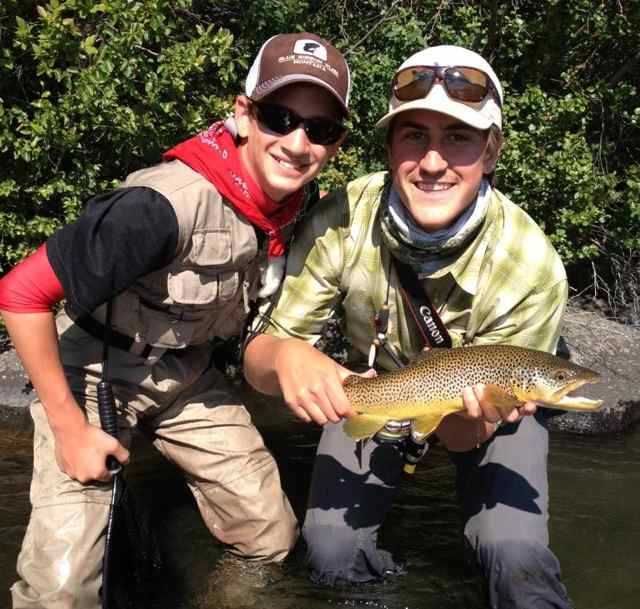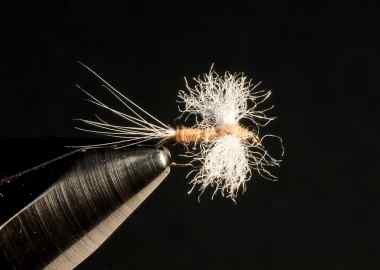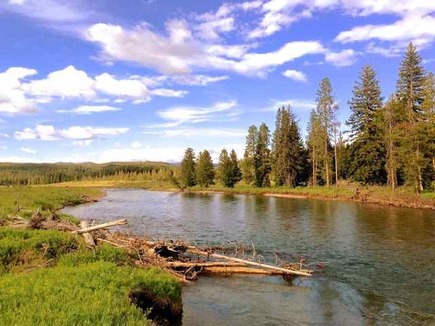Long Range Fish Report
From Sportfishing
From Sportfishing
Fish Report for 7-25-2013

What's Happening in Yellowstone Country
7-25-2013
Craig Mathews
I just got in from fishing the heaviest spinner fall I've ever seen on the river. Earlier this week I thought it to be only Epeorus spinners bringing trout to the surface nightly from 8-10p.m., I was wrong, again. Typical deal, I'd been fishing evening pink lady spinner falls for weeks now as they came down the same time caddis emerged. For the last few evenings I'd been meet with refusals or trout simply ignored my offerings. Tonight though I took time to do what the river told me to do. The spinners looked somehow larger and moved quicker than pink ladies, darting and soaring overhead searching for a mate. I took off my hat and swiped wildly at the wave of mayfly spinners hovering over my head. After a couple tries I scored 2 spinners, both males. You will most likely read more about this in our 2013 Year in Review coming in December but for now a #14 Hi Viz Rusty Spinner is all you'll need to fool big rising trout. I'm guessing Rhitrogenia spinner. I've noted this spinner gaining in population over the past few years, much like we have seen a tremendous increase in Epeorus spinner numbers over time. From a fishing standpoint you will need to have a good imitation of this mayfly spinner when fishing the Madison during evening hours in order to be successful. Iris and X2 (or X) in tan along with an Epeorus Cripple or Sparkle Dun and spinner and you will take many fine rising trout on the river for the next few weeks.
Pictured Above: Chandler Starks and Peter Scorzetti with a beautiful Brown!
Photo by Lamar Starks
Last week's news began with our working on a fence line to protect west slope cutthroat habitat and riparian areas. We got the fence in and it is working great. We now are working on an experimental 6000 foot pipeline to bring water to a 1000 acre pasture never used before. Our goal is to keep cattle away from, and protect trout habitat in nearby sensitive riparian areas. At the same time we hope to freshen the pasture's native grasses by lightly grazing the area with resultant regrowth of nutrient rich forage for wintering elk. Stay tuned and I'll bring you more on this through the late summer, fall and next winter.
Photo #1: Photo of the work being done to improve the habitat in nearby sensitive riparian areas.
Photo by Aaron Freed
Yesterday I spent the day with Todd Tanner of "Conservation Hawks" who also writes for Sporting Classics magazine. Todd is working on a piece for this publication on conservation and our 1% for the Planet program. I'll let you know when the article comes out. One of the threads Todd will weave through the article is how important it is for anglers to support those businesses that give back to organizations that protect, preserve and enhance conservation projects like wild/native trout and wild places, clean water and more. You are all aware of 1% for the Planet, Madison and Henry's Fork River Foundations, Yellowstone Park Foundation and Conservation Hawks and so many other great NGO's that work hard to protect what we all enjoy and love as we pursue wild trout. We appreciate your kind support of Blue Ribbon Flies and hope you will spread the word on shopping with us and like-minded business that give back to organizations that do the work to preserve for us and our kids and grandkids what we love so much. It does make a difference.
For instance, last year Yvon Chouinard and I helped design a Tenkara rod that TFO Rods manufactures. The rod model is called simply the "Soft Hackle", and comes in 10'6" and 11'6" lengths, the perfect rod for much of our fishing needs. A portion of the sale of each "Soft Hackle" TFO goes to the Madison River Foundation resulting in over $6000.00 to the foundation in a year.
Yellowstone country will be in full terrestrial fishing mode soon and this will continue into October. While wildflowers are still in bloom and valley grasses remain green with the moisture we've received this summer things will begin to dry and brown out and insects will head to the remaining green vegetation along the rivers and streams. Late summer means grasshoppers, crickets, beetles and ants and bees become more and more important in trout diets as some aquatic insect emergences wane. Now is the time to stock your boxes with terrestrials and head to our rivers, lakes and streams and cash in on big trout taking land born bugs.
This season has been one of heavy insect emergences bringing big trout to the surface. It continues. Be here! Read below and I hope to see you soon on a Yellowstone country river, lake or stream.
As usual in the rest of this issue, you'll find fishing news from Yellowstone Country in the weekly Fishing Report. You can see what's hot off the vise in the Fly of the Week, get a sneak peek at some of the best materials on our tying bench in the Fly Tying Material of the Week, and stay up to date with the guide staff and their trips in the Guide Trip of the week.
You'll be seeing a new email newsletter most every week throughout the spring and summer to keep you tuned in to all things fly fishing and fly tying in the greater Yellowstone area and beyond. Throughout the seasons, we'll keep sending you news of hatches and fishing holes around West Yellowstone. So without further delay, go ahead and jump right into the newsletter. And as always, don't hesitate to give us a call or shoot us an email if you have any questions, or if you just want a little fish talk.
Pictured Above: Chandler Starks and Peter Scorzetti with a beautiful Brown!
Photo by Lamar Starks
Last week's news began with our working on a fence line to protect west slope cutthroat habitat and riparian areas. We got the fence in and it is working great. We now are working on an experimental 6000 foot pipeline to bring water to a 1000 acre pasture never used before. Our goal is to keep cattle away from, and protect trout habitat in nearby sensitive riparian areas. At the same time we hope to freshen the pasture's native grasses by lightly grazing the area with resultant regrowth of nutrient rich forage for wintering elk. Stay tuned and I'll bring you more on this through the late summer, fall and next winter.
Photo #1: Photo of the work being done to improve the habitat in nearby sensitive riparian areas.
Photo by Aaron Freed
Yesterday I spent the day with Todd Tanner of "Conservation Hawks" who also writes for Sporting Classics magazine. Todd is working on a piece for this publication on conservation and our 1% for the Planet program. I'll let you know when the article comes out. One of the threads Todd will weave through the article is how important it is for anglers to support those businesses that give back to organizations that protect, preserve and enhance conservation projects like wild/native trout and wild places, clean water and more. You are all aware of 1% for the Planet, Madison and Henry's Fork River Foundations, Yellowstone Park Foundation and Conservation Hawks and so many other great NGO's that work hard to protect what we all enjoy and love as we pursue wild trout. We appreciate your kind support of Blue Ribbon Flies and hope you will spread the word on shopping with us and like-minded business that give back to organizations that do the work to preserve for us and our kids and grandkids what we love so much. It does make a difference.
For instance, last year Yvon Chouinard and I helped design a Tenkara rod that TFO Rods manufactures. The rod model is called simply the "Soft Hackle", and comes in 10'6" and 11'6" lengths, the perfect rod for much of our fishing needs. A portion of the sale of each "Soft Hackle" TFO goes to the Madison River Foundation resulting in over $6000.00 to the foundation in a year.
Yellowstone country will be in full terrestrial fishing mode soon and this will continue into October. While wildflowers are still in bloom and valley grasses remain green with the moisture we've received this summer things will begin to dry and brown out and insects will head to the remaining green vegetation along the rivers and streams. Late summer means grasshoppers, crickets, beetles and ants and bees become more and more important in trout diets as some aquatic insect emergences wane. Now is the time to stock your boxes with terrestrials and head to our rivers, lakes and streams and cash in on big trout taking land born bugs.
This season has been one of heavy insect emergences bringing big trout to the surface. It continues. Be here! Read below and I hope to see you soon on a Yellowstone country river, lake or stream.
As usual in the rest of this issue, you'll find fishing news from Yellowstone Country in the weekly Fishing Report. You can see what's hot off the vise in the Fly of the Week, get a sneak peek at some of the best materials on our tying bench in the Fly Tying Material of the Week, and stay up to date with the guide staff and their trips in the Guide Trip of the week.
You'll be seeing a new email newsletter most every week throughout the spring and summer to keep you tuned in to all things fly fishing and fly tying in the greater Yellowstone area and beyond. Throughout the seasons, we'll keep sending you news of hatches and fishing holes around West Yellowstone. So without further delay, go ahead and jump right into the newsletter. And as always, don't hesitate to give us a call or shoot us an email if you have any questions, or if you just want a little fish talk.
Photos
< Previous Report Next Report >
More Reports

7-25-2013
Hydropsyche Caddis, the longtime heavyweight champion of evening fishing in Yellowstone Country has had a formidable opponent in the battle...... Read More
Craig Mathews Reports
for Thursday, July 18th, 2013Yellowstone Fish Report: Yellowstone Fish Report, July 18, 2013

LongRangeSportfishing.net © 2025. All Rights Reserved.
Website Hosting and Design provided by TECK.net
Website Hosting and Design provided by TECK.net
